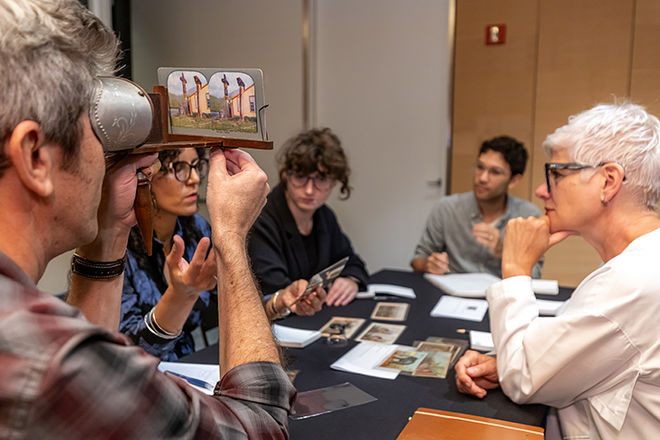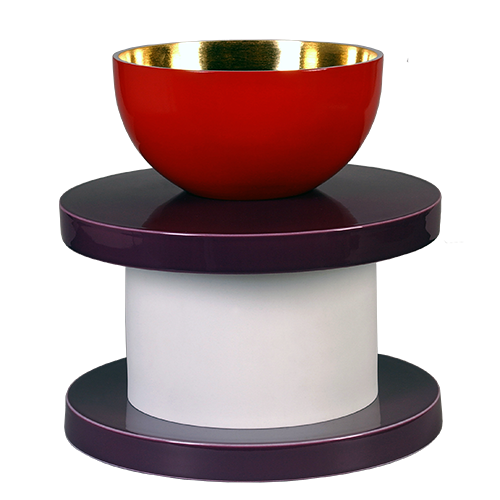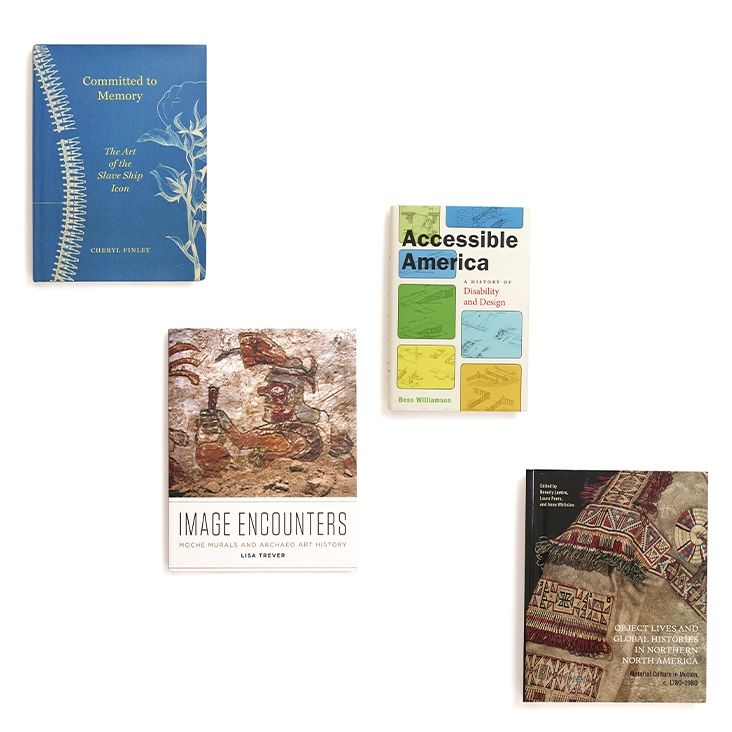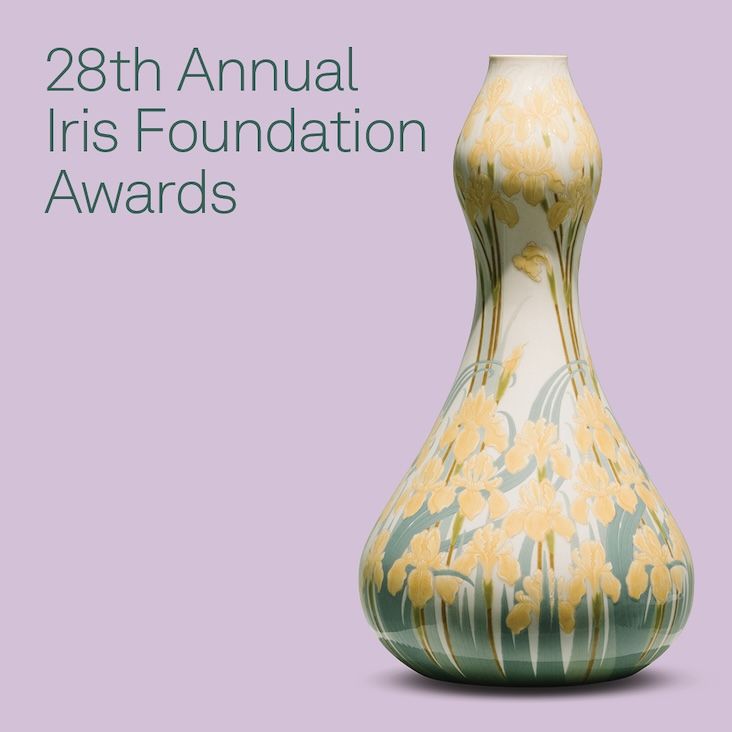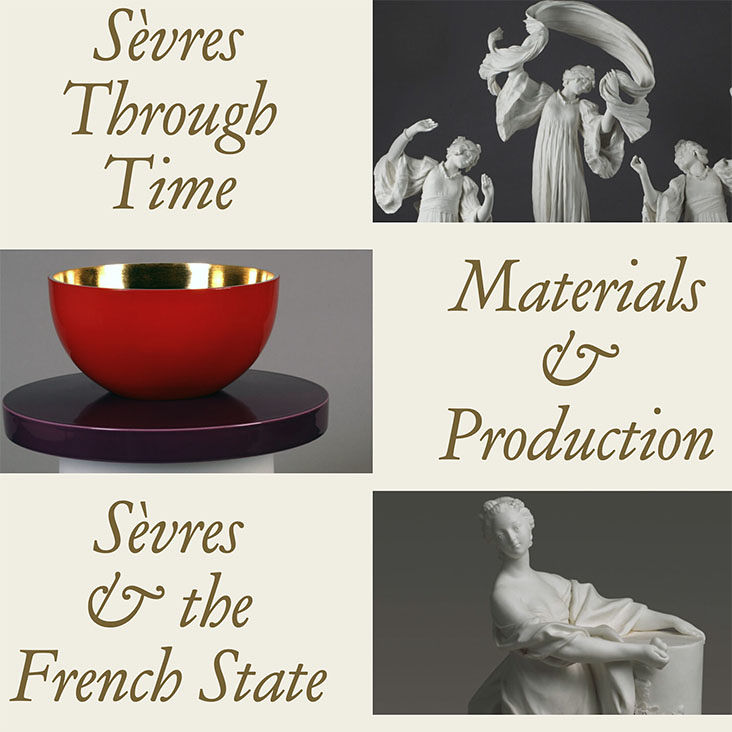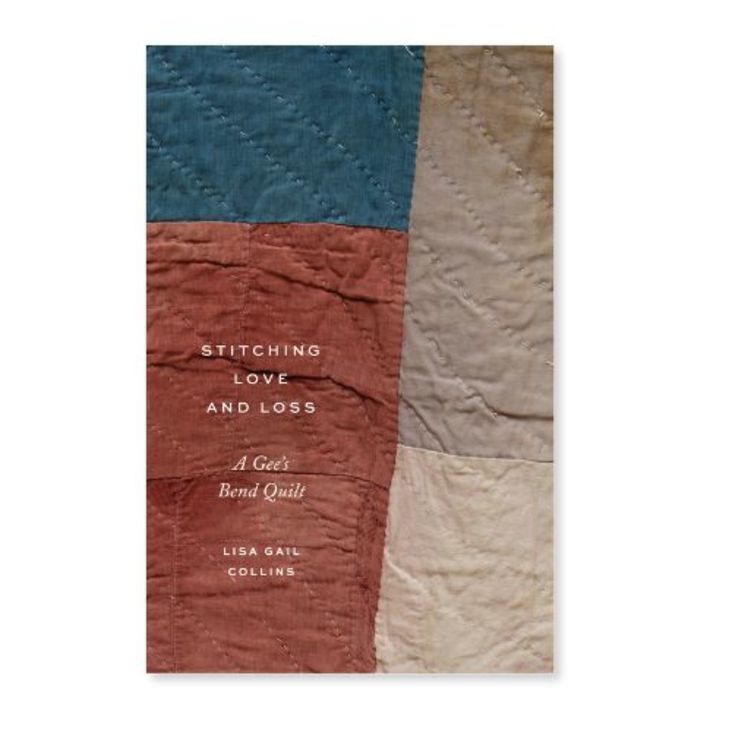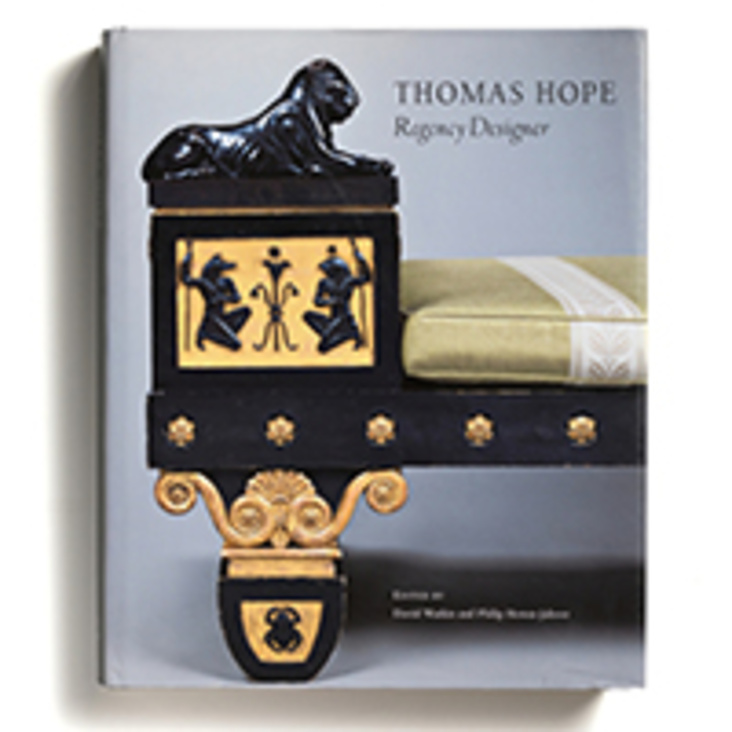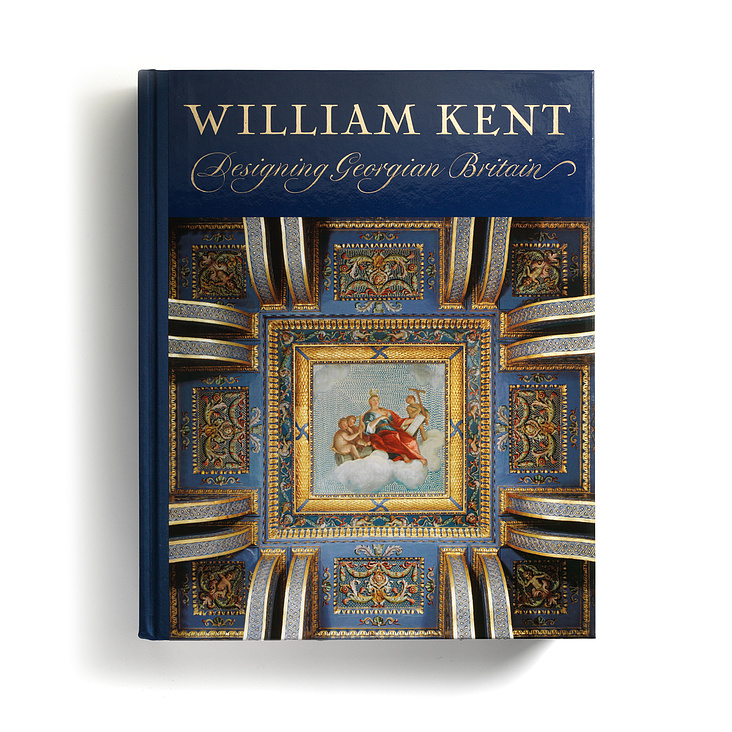Originally published in Vasemania: Neoclassical Form and Ornament in Europe: Selections from the Metropolitan Museum of Art, edited by William Reider, Stefanie Walker, and Hans Ottomeyer. New Haven and London: Published for the Bard Graduate Center for Studies in the Decorative Arts, New York by Yale University Press, 2004. 15-29.
The vase was a leitmotif during each of the
three main phases of neoclassicism: the early, experimental goût grec; the mature, elegantly exuberant goût étrusque; and the late, more restrained
goût antique, often
called Empire. Designing and producing
vases for a multitude of purposes became one of the main challenges for eighteenth-century
designers. Why were vases
so attractive to them? The reasons transcend
issues of stylistic
development
or historical events and
go back to the elemental
properties of the form.
The vase is a vessel whose walls rise vertically from its foot. Depending on its shape, it can be described as
a basin, bowl, ewer,
goblet, pot, urn, and more. Vases are constituted of basic parts with names derived
from the human form: foot,
neck, and handles, the latter often set like arms onto the shoulders of the vessel’s body. This reversible metaphor was
well known since antiquity. Cicero, for example, compared the human figure to a vase: “for the body is like a vase and like the vessel of the soul.”’ Beyond its anthropomorphism,
the vase possesses another
quality that made it an obvious choice for neoclassical designers.
Its body offers a continuous, ring-shaped image field that permits a frieze like composition to
run around it like a panorama turned inside-out. Without
the limits of a frame, sculptors and
painters found that they could employ a vessel’s continuous surface as a background for reliefs,
bands of figures,
and an endless variety of repeating patterns. Regarding
their placement and
display, vases are similar to sculptures. They stand on bases, socles, or plinths or they can serve as crowning features
of both an interior and exterior setting. In this context, they become exclusively objects of aesthetic contemplation, removed from any utilitarian purpose.
The function of
vases has changed considerably over time.
In antiquity they were used as containers for wine, oil, and water, as
well as for ceremonial purposes at
feasts and sacrifices. They also served as presents, trophies,
or temple offerings,
and thereby conferred honor on their recipients or provided a
source of aesthetic contemplation. This was the case, for example, for the Panathenean games, where the winner received
a trophy vase as
a prize. However,
what secured the form’s survival over millennia was its
use as a burial gift and
funerary urn.
It was not
customary in ancient Greece to provide the dead with artistic
vases to accompany them on their final journey. However, among the Etruscans and those Greeks who lived in the Roman
Campania and in southern Italy, the bestowal of precious Greek vases upon the deceased became common; this was true as well as for the Thracians, Macedonians, and Celts. Later,
for centuries in the areas dominated by
Rome and its extended empire, marble- and
ceramic- relief burial urns (called cippi in Italian, from the Latin cippus, or headstone) were produced to contain the ashes of the dead. Collected
since the Renaissance,
first in Italy and then throughout Europe, vases had an immense aesthetic impact, equal to
that of monumental sculptures; together, they determined the image of the ancient
world. In fact, because stone vases adorned with friezes
were frequently excavated undamaged, their influence could exceed that of frequently fragmented
sculpture and architectural examples. With their visual vocabulary intact, vases became guiding forms for studying and interpreting the ancient world. As Werner Oechslin,
author of the most complete exhibition and monograph on the vase to date, stated, “The
vase belongs [entirely] to
antiquity.”
The Renaissance, mannerist, baroque,
and neoclassical periods—each with its own
view of antiquity—absorbed the designs of classical vases and made choices, variations, and new interpretations that entered their own artistic
canon. Renaissance
designers defined the
vase as a clear, geometric body; bizarre and grotesque motifs on ancient vessels fascinated proponents of mannerism; baroque artists approached them as sites for lavish figural compositions; and devotees of neoclassicism admired their
noble simplicity and serene contours. With its inexhaustible diversity, the classical
vase provided each of these revival periods with models to imitate and elaborate upon. In that regard,
the vase’s principle function changed.
From an object intended for use, it turned into a multilayered template for ornamental and iconographic invention. Thus, it seems safe to say that the concept of
“art for art’s sake” did not first
occur with the aesthetic movement in
the late nineteenth century, but rather at least one hundred years earlier. In
the neoclassical period, the vase fascinated artists as
a format unencumbered by
functionality, one that offered infinite
possibilities to express design
and style
in a play of abstract overall
shape, geometric planes,
and two- and three dimensional
images.
In Europe the
vase enjoyed its greatest popularity
as a cultural
icon between 1700 and 1825. Those conceiving, decorating, and making vases included architects, designers, sculptors, painters, bronze workers,
porcelain makers, and iron founders—
all translating the
classical prototype’s shapes and themes into their respective medium. For inspiration they often turned to famous large, sculptural vases of Roman origin, such as the frieze
of ancient gods on the Borghese
Vase (Fig. 1), the sacrifice
of Iphigenia on the Medici Vase (Museo degli Uffizi, Florence),
the satyr masks on
the Warwick Vase (see cat. no. 2), and the enigmatic scene of gods and goddesses on
the
Portland Vase (see cat.
no. 8). Documentation of
such models in contemporary
drawings, prints, and pattern books tended to obscure a
sense of the antique prototype’s true size. An artist who wished to focus attention on his technical mastery might make
his vase huge, entirely out
of scale in comparison to the original, or
vice versa. Likewise, the connection of a specific shape to
particular materials and techniques
was lost. Thus, the painted figural frieze of an Attic vase could become a
gilt-bronze relief on a blackpatinated background; or the sculptural figures of a marble vase might
turn into a lustrous painting on
porcelain.
Some
of the inventions of
the neoclassical period stem from a vase type known only from
its mention in
ancient literature. Vasae mvrrhinae, or myrrhine vessels, were made of a precious
material that the ancients never explained clearly. Were they composed of a rare silver alloy, agate, fluorspar, a
two-colored precious stone? The unknown material of these vases, which antiquity valued above all others, prompted
many to search for
more about them. As a lexicon from 1846 states,
They were made out of a variously colored,
opaque, but very fragile material,
of which nothing has been preserved. For that reason, people made the most diverse
conjectures about the actual
composition
of the mass, especially
because the name of the vase, as well as that of the material, is
neither Greek nor Roman, but stems
from Asia. In dispute with one another, later and more recent archeologists considered the
material to be a kind of
chalcedony with variable colors, like girasol
or kacholong, or
to be dendritic agate, sardonyx,
fluorspar, or the Chinese precious stone yu.
According to
Caylus, the material consists
of iron slag; according to Veltheim, Chinese soapstone; according to Böttger and others, glasslike porcelain, an imitation of the ancient
Greek porcelain.
Certainly, during the
neoclassical period, many experiments
with various materials, to
which we owe some of the most stunning results, can be traced to the mythical myrrhine vessels and the search for clues to their existence and composition. This
exploration of the unknown liberated
both artistic imagination and technical invention, resulting in totally new forms and materials. In the eighteenth century,
it gave us, for example, the shimmering fluorspar vases of Matthew Boulton
(see cat. no. 45), the two-colored biscuit porcelain vases of Josiah Wedgwood
(see cat. nos. 40-44), and the iridescent opaline glass vases of Russian
and French manufactories.
In each of neoclassicism’s three periods, the vase underwent
essential changes beyond size and materials, but
remained decisive in the development of each phase
as the main symbol for
the venerable tradition of
the ancients. The monumental
antique funeral urn was transformed into a commemorative vessel,
then took on a hedonistic quality
reflecting the ancient cult of Venus and Bacchus, and finally celebrated the victory of reason and
Apollonian idealism. To
understand and appreciate the great
variety of its forms and
meanings, the
vase and its history must be examined more closely.
Early neoclassicism, or the “goût grec”
Shortly before the mid-eighteenth century, people began to criticize the
predominant rococo manner, or goût pittoresque,
with its curvilinear and asymmetrical designs,
as exaggerated and ridiculous. Architects and connoisseurs recommended a return to centuries-old patterns and traditions, which resulted in a more
spare and rectilinear style based on ancient architectural
ornamentation. This revival of
classical standards and motifs led
to concepts of
grandeur and simplicity that were consciously
infused with
moral dimensions. In France-the European
leader of artistic fashion -this was accompanied initially by
renewed appreciation for baroque furniture, for example. The sobriety and majesty of pieces by André-Charles Boulle, the legendary
founder of seventeenth-century artistic cabinetry, made them highly collectible. Because of
their rarity, reproductions appeared in France. The period gave rise to several seminal publications reflecting revived interest in the late seventeenth and early eighteenth centuries: besides Voltaire’s
histories of the era of Louis XIV, editions of seventeenth-century prints were reissued. For instance, in 1751 Charles-Antoine Jombert published
the entire oeuvre of the designer Jean Le Pautre, as well as
Daniel Marot’s engravings of designs and models
for furniture and interiors, which suddenly appeared fresh and modern. From these
volumes, one can trace almost the entire ornamental repertory of the first stage of neoclassicism, the goût grec (“Greek
taste”). Trying to maintain
the rules of classical
architecture, this style emphasized a simple, basic structure and embellished it with layers of ornament, such as antique bands, friezes, and leaf motifs, all distantly related to Greek
and Roman architectural decoration. Characteristic of the goût grec is the almost exclusive use of highly stylized, almost abstract ornament, far removed from any naturalism. The comparatively larger scale of these motifs and their often entirely unclassical, additive composition reveal the degree to which the distance
of intervening centuries
had transformed them. How and why this manner came to be called
the goût grec is closely
connected to the origin
and significance of early neoclassicism.
The driving force behind neoclassicism and the goût grec
was the Comte de Caylus, a
former French diplomat
and man of letters, whose studies and collecting activities made him into one of the foremost critics and archeologists of his time. His collection of Egyptian, Greek, and Roman art became the focus of an
influential catalogue that appeared in fascicles between 1752 and 1767 in
Paris, entitled Recueil d’antiquités Égyptiennes,
Étrusques, Grecques, Romaines, et
Gauloises. In the third chapter
of each of
the publication’s seven volumes, Caylus discussed the
Greeks. Citing Roman authors, he concluded that Greek art and civilization constituted the high point of antiquity, and to support
this thesis he quoted
Roman authors of the same persuasion. Johann Joachim Winckelmann echoed this belief in
Die Geschichte der Kunst des Altertums, issued in 1764. Neither
author had visited Greece; they had barely seen an original Greek work of art, except for vases from excavations in
the southern Italian region of Campania, which they believed to be Etruscan. When the cognoscenti labeled an object “Greek,”
therefore, what they actually meant was something executed in the very best of ancient
styles
and therefore precious: the term itself was a
misnomer.
Nevertheless, such writing and points of view did set into motion
a concerted effort to find the remains of Greek architecture and art. Supported by Caylus, a young architect, Julien-David Leroy traveled around Greece in 1754-55. He published Ruine
des plus beaux monuments
de la Grèce in 1758; a second, revised edition appeared in 1770. With the exception of his rendition
of the palmette friezes on the Erechtheion, in Athens, which were adapted as decoration in interiors
and on objects, this monograph had no immediate effect on French ornamentation, and
this nation’s decorators continued to employ conventional
design patterns.
Another undertaking, again in Caylus’s
circle, had a greater impact on the development and establishment of the goût grec as a fashionable style. Ange-Laurent de Lalive de Jully, a wealthy art collector who served as chief of protocol at the court of Louis XVI at Versailles, commissioned a set
of furniture for his “Flemish
chamber” in 1756. For this project, he hired a young architectural
painter, Louis-Joseph Le Lorrain (see cat. nos. 88-89), who,
since his return from studying in Rome, had enjoyed Caylus’s patronage. Influenced by the art of his
contemporary Giovanni Battista Piranesi, Le Lorrain’s monumental and dramatic images of
architecture caused a sensation
and had made the artist quite successful in
Rome.
While Le Lorrain employed
classical motifs, he decorated surfaces in a baroque manner not unlike that of Le Pautre. Le Lorrain’s ideas for
interiors were particularly
inventive.’° For Lalive de Jully, he
designed a desk with
an upper filing section (Fig. 2), a matching chair, a bronze inkstand executed by Philippe Caffiéri II,
and a clock in the shape of a
vase with a horizontal ring of hours: the first documented use of the vase form for such a purpose.
In these pieces, Le Lorrain succeeded in translating architectural concepts into furniture
designs without compromising their classical expression. So
effusive was Caylus
in his praise of the ensemble that many notable Parisians hurried to see the ultramodern furniture. La live de
Jully
wrote in 1764, “Since the execution of this cabinet, the taste in works ‘à la grecque’ has spread. Now one applies it in a ridiculous
fashion to everything: to table china,
jewelry, fabrics, haircuts, and even to shop signs,
all of which are today ‘à la grecque.’” Critic Charles-Nicolas Cochin declared:
[At
the time,] all upstanding people used ancient ornament entirely falsely. They distorted them, decorated
their window seats with heavy decorative bands and
committed a thousand other stupidities. The painter Le Lorrain designed in a heavy style the furnishings for the apartment of M. de la Live, a
wealthy art lover, who also drew a little. The fame
of the
[ensemble] increased
when the Comte de Caylus praised
this undertaking enthusiastically.
From that stemmed the garlands [that resemble]
well ropes; vases that, according to ancient usage, contained liquids became
clocks with hour dials rotating
around them, beautiful
inventions that were imitated by all the ignorant; and Paris was flooded with every possible thing à Ia grecque.
From such accounts and many surviving
examples, it is clear that practically all types of decorative arts produced during the economic boom that followed the end of the Seven Years’ War in 1763 were conceived in the
goût grec idiom, but, because of
overuse and exaggeration, the style was already beginning to
be discredited by 1770 for being unnecessarily heavy and ornate. The preeminent artist-designer of the short-lived goût grec, Jean-Charles Delafosse, must be mentioned in this context, for he published his influential
Nouvelle Iconologie historique in 1768, after a number of years of preparation (sec Fig. 3). His detailed, bizarre designs, which almost always feature monumental
vases, are complex. The designer’s
vessels consist of individual motifs
interlaced or stacked within or atop one another,
resulting in an overall abstract
effect (see cat. no. 9). Delafosse’s forceful and attractive compositions were adapted, directly and indirectly, to numerous vase and ornament
designs. But the vases actually
produced in his style simplified the repertory of his forms,
resulting in a lighter, finished
appearance that helped keep their production cost down (see Fig. 4). Enhancing
the significance of these vase designs for the decorative arts was the
devotion of practitioners of early neoclassicism to monumentality and
grandeur, which they achieved using a vocabulary of columns, pilasters, architraves, friezes, and vases. In this typology, the
central and crowning elements were classical vases, which thus became the iconic motif of the goût grec. They
appear frequently as finials, for example, on cartel clocks and silver vessels (see cat. no. 50), as well as on sconces atop a main structure shaped by pilasters.
Nonetheless, between 1755 and
1770, when the goût grec dominated, a lingering
taste for the rococo
is discernible in many transitional designs. Not everyone
was prepared to fully embrace
the goût grec’s strict and logical approach, one that broke with familiar and friendly forms. Commenting on the ubiquitous
presence of the acanthus-leaf motif in goût grec designs, the
Marquis de Marigny, brother of
Madame de Pompadour, declared: “I
want neither the
modern cabbage [style], nor the austere ancient [one]. Half of one, half of the other.” This expression of
ambivalence toward the new, neoclassical manner —which, after the spirited asymmetry of
the rococo, seemed overly formal, even rigid— reflects the attitude of
the court and aristocracy, who
would
only consider such a break with
the long-lasting, previous development as a fashion
alternative, not a binding choice.
Appearing first in this archaizing and dogmatic form, goût grec neoclassicism
attempted to legitimize itself by evoking a revered
and distant era, considered more
moral and sound than the present. One is tempted to
call it the first historicizing style, except for the fact that its proponents lacked accurate knowledge of
actual historical sources. It remained for the subsequent generation to dedicate itself to a more
scientific
study of antiquity
and to forge a revised
image of it.
The grotesque
style, or the “goût étrusque”
The
next phase of neoclassicism differed from the goût grec by incorporating other views and new models. Evolving uninterrupted from about 1775 to the end of the ancien régime, in 1789, the
style was encumbered with a confusing
series
of names that contemporaries used to identify it: goût étrusque (“Etruscan
taste”), genre arabesque (“arabesque type”), or a combination of the two. While
neither Etruscans nor Arabs had anything to do with the style’s
forms or ornamental vocabulary, one can determine what was intended
with these consistently and longemployed designations. In descriptive terms, the goût étrusque should
more correctly be called a grotesque style. Grotesques (grotteschi) refer to the stucco
and painted ornaments
created by Renaissance artists, such as
Raphael and his followers, in the early 1500s. They based such designs on the findings
yielded by contemporary excavations of
Roman palaces, for example the
Domus Aurea, where wall and ceiling
decorations were found underground, in what were thought to be grottos. Derived from both new archeological discoveries and Renaissance prototypes, the visual language of this eighteenth-century revival relied upon naturalistic ornamental motifs and chimerical
figural inventions, arranged in mirror image around a central axis, almost always in
the form of a plant or fountain
rising from a vase (see cat. no. 79).
The complex ornamental motifs of this manner were well
suited for vase decoration and quickly assimilated into new designs (see Fig. 5). The compositional principle
of the style is embodied in the acanthus volute:
axio-symmetric, curvilinear, terminating in a spiral.
Reflecting the new manner, vases for example were embellished with curved fluting and curling designs on the friezes of volute handles. Designers inserted grotesque forms into these foliated compositions: sphinxes, chimeras,
griffins, harpies, berms, and frequently humans (see Fig. 6). On panels designed
for interiors, for instance, one typically finds male or female torsos emerging from a frond of acanthus
that itself rises from a vase. Accompanying these fantastical figures is the
entire Bacchic retinue —satyrs, maenads, billy-goats, rams,
and Pan’s children— as well as
their attributes: grapevines, grapes, musical instruments, overflowing
cornucopias, garlands,
festoons, and fruit baskets. This naturalistic and hedonistic imagery, evoking the
world
of Bacchus and
exuding a pronounced
joie de
vivre,
contrasts emphatically the heavy architectural
forms, sober abstract
friezes, and rigorous intellectual imagery of
the earlier goût grec manner.
This infusion
of vitality and playfulness was
the result of a new understanding of everyday life in the ancient
world. Behind or beyond the august temples
and other columnar
structures, archeologists found,
to their amazement, remains of
Roman palaces and houses
with lively and colorful decorations that
often included vase motifs. Such discoveries occurred in
or near Rome, mainly in the imperial palaces in the Palatine
Hill area, and in Tivoli, where Hadrian’s Villa was investigated. Designers adopted
motifs from these painted
and stuccoed wall decorations and from sculptural elements
of buildings in the imperial fora. High Renaissance architects and decorators had been inspired by
these models, but also by other ancient sites that had since
been destroyed or buried. This made sixteenth-century works an obvious source for neoclassical artists.
The appellation “Etruscan style”
for objects and interiors of the mid-1770s to
the 1780s requires
further explanation. For a long time, “Etruscan”
was a catchall term, encompassing the entire
archaic period of ancient
art. This included vases actually of Greek origin but
found in Campania in southern Italy, as well as archaizing works dating from Roman imperial times. The
term was used as well to describe work that was considered
ancient, but neither Greek nor Roman. Caylus entitled the second chapter of each volume of his Recueil d’antiquités “Des Étrusques”; here, he attempted to define the character of
“Etruscan” art. He could not resolve the contradiction between the elemental forms
of genuine Etruscan bronzes and the compositional
complexity of Attic vases;
thus, from the beginning, étrusque was a vague concept. Caylus, who changed
his mind about Etruscan art from volume to volume,
admitted: “One cannot say anything definite
about the Etruscans.”’
A related issue was the prominent debate about the nature of
Greek versus Roman art, and which of the two was superior. The most vocal proponent for the Etruscans and Romans against
the views of Caylus and Winckelmann, who, as we have seen, supported Greece, was Giovanni Battista Piranesi (see
cat. no. 2), the famous printmaker and designer, who was also a respected antiquarian scholar and archeologist in his own right. Piranesi’s Diverse maniere d’adornare i cammini, published in 1769, figured in the discussion. In his preface,
Piranesi acknowledged a partial influence of Greek on Roman
art, but championed the latter as having successfully combined elements
from different periods into a new, superior style. This then became the justification and model for his own eclectic designs. For the most part, the sixty-five pages of Diverse maniere contain designs for fireplaces, which Piranesi chose as a subject precisely because
they did not exist in antiquity and he could exhibit his ability
in adapting ancient ornamentation to modern needs. The volume also includes ideas
for andirons, tripods, chairs,
clocks, candle holders, console
tables, sedan chairs, commodes, and of course vase designs that
combine Greek and Roman models. Piranesi drew from his extensive knowledge
of antiquity to
rethink the embellishment of
furniture and other objects,
but only in terms of motifs he applied to
his forms; he did not adopt any single style entirely.
Although in his foreword Piranesi emphasized the role of
Etruscan art, the volume contains
no design that could truly be described as such. Avoiding
a clear definition, Piranesi explained that, like the Romans, he
mixed this style with that of the Greeks, leaving it to the connoisseur to distinguish
one from the other. For Plate I, in the preface, he created
114 small images with all the objects
and motifs he considered Etruscan.
He argued that they should be
employed for wall decorations, as he believed they had been in antiquity, an
opinion echoed by Sir William Hamilton
in the foreword of the first volume of
his Collection of Etruscan,
Greek and Roman Antiquities…, published in
1767.
Hamilton began the first of
his influential collections of
ancient vases-some of which he designated as “Etruscan “— while serving as British ambassador to the Kingdom of Naples (see Fig. 7). He sold this collection to the British Museum, London, in 1772. With the profit, he created a second collection, whose origin he correctly recognized as Greek; his publication of this group (1791-95) features line drawings —derived from the original vases—
by the German artist Johann
Heinrich Wilhelm Tischbein.
Hamilton’s collections and catalogues prompted
a taste for Attic red- and black-figured vases and quickly set the standard as sources for contemporary artist-designers. The illustrations also encouraged a vogue for the linear rendering
of forms (gravure au trait). This
soon became a particularly pervasive
method of Rome-based artists
working in all media, a direction reinforced by Winckelmann’s influential aesthetic
pronouncement on the primacy
of the contour in ancient sculpture. In addition
to this emphasis, frieze decorations restricted to
two colors became an
essential design principle for vases and other arts toward
the end of the century.
Among the canonical items in this refined “Etruscan” style were the internationally distributed vases of the English
ceramist Josiah Wedgwood. His work, inspired by ancient and Renaissance models, as well as the publication of Hamilton’s first vase collection, constitutes a major achievement in the field of
neoclassical vase design and manufacture. In the 1760s, Wedgwood produced cream ware (see cat. nos. 31-33) and black
basalt vases in classical shapes (see cat. nos. 36, 38-39), the
latter often decorated
in orange-red encaustics, in imitation
of Attic prototypes (see cat. no. 5).
At his manufactory, which he established in 1769 and called Etruria, he employed neoclassical designers, most notable among them the sculptor John Flaxman (sec cat. nos. 7, 42). Working
assiduously to create a line of vessels and
tableware that were closely
allied to antique
styles, Wedgwood based his jasper ware, which involved applying a
light-colored relief over a darker ceramic background, on ancient cameos and cameo glass (see cat. nos. 6-8,
40-44). Flaxman
took this two-dimensional approach
to another level,
especially in his illustrations for the Iliad (1793) and the Odyssey (1795). Wedgwood’s most famous ceramic copy of antique cameo glass
is certainly that of the Portland Vase, an extraordinary tour de force and elaborate homage to
antiquity (cat. no. 8).
Like Hamilton and Wedgwood, the Scottish
architect Robert Adam played a
decisive role in the development of the mature, refined phase of neoclassicism by
translating his experience of the art of
antiquity into concepts
and forms suitable
for contemporary interiors and vase design. On his extended
Grand Tour, Adam hired
the influential neoclassicist Charles-Louis Clérisseau in 1757 as his drawing teacher, and they traveled in Italy together. By 1778, when Adam published the first volume of his Works in
Architecture,
he noted the confusing terminology used by
contemporaries, adding a decided swipe at
French rivals:
The
French, who till of late never adopted the ornaments of the ancients, and jealous as all mankind are of the reputation of their national
taste, have blended together those ornaments
with the vague and fantastical appellation
of arabesque, a style which, though entirely
distinct from the
grotesque, has notwithstanding been most absurdly
and universally confounded
with it by the ignorant.
Indeed, the floral and vegetal components of the grotesque manner are shared by the arabesque, a type of ornament thought to have derived from Near East. The
term
was used from the late sixteenth century on; by the seventeenth, it was [mis]applied to any type of scrolling design, causing confusion in terminology.
Despite his desire
for distinct nomenclature, however,
Adam, like Piranesi, recommended that one not follow antique sources slavishly, for they represented a style developed over time based on
numerous historical precedents. Instead, he believed that architects and
designers should grasp the spirit
of antiquity, which Adam expressed as “…all gaiety, grace and beauty.” In his
case, it is dear that “Etruscan” was not to be understood
literally or historically, but rather as a new, synthetic style based upon Roman
art and its rediscovery and interpretation in the High Renaissance. Adam described his method as follows: “We have introduced a great diversity
of ceilings, friezes, and decorated pilasters, and have added grace and beauty to
the whole, by a mixture of
grotesque, stucco, and painted ornaments together with the flowing rinçeau with its fanciful figures and winding foliage.”
Parallel and very much in competition to developments in England, a similar grotesque style came to characterize eighteenth-century
interior decoration in France, exhibiting a lexicon of forms that frequently included vases. An
early
such example is provided
by a series of eight panels originally from the Hôtel Grimod de la Reynière, Paris, and datable to
1773-75 (they are now in the Victoria
and Albert Museum, London). These panels were set above
a wainscoting decorated
with garlands between
three windows which corresponded to mirrors on the opposite wall. They display
vases
in the center of axially symmetrical grotesque
ornamentation. The drawings of the original
disposition of the interior by Jan Chrystian Kamnsetzer show
that four candelabra, in the form of large vases on tripod supports, complemented the painted decoration (see Fig. 8). In this instance, the two-dimensional, painted vase motif moved from the
wall into the room, as it were, as
a volumetric,
independent form.
Some of
the most beautiful neoclassical vase designs
of the 1770s came from the architect-designer Francois-Joseph Belanger. He interpreted the ancient grotesque
style in a new way, drawing upon hand-colored publications of the Vatican Loggie, which inspired his 1777-81 decoration
of the salon at the Château de Bagatelle le in the Bois du Bologne,
near Paris. This interior featured
pink -ground panels with low-relief
figures by Nicholas-François-Daniel pastel ground were medallions containing grisailles or cameos resembling Wedgwood designs, as well as beautifully carved, gilded, and painted overdoors with vases as their central motif (see cat. no. 74). Belanger’s greatest
contribution to neoclassical vase design, however, was a group of vessels he created for the Due d’Aumont.
Around 1772 the duke, inspired
by ancient marble and porphyry vases, began to search for valuable
French hardstone deposits that could be made into a variety
of vessels, which would be sanded, polished,
and fastened together
with gilt-bronze settings. He hired Bélanger to design
the shapes and mounts; the
latter were executed
by the most famous bronze caster and chaser of the era, Pierre Gouthière (see Fig. 9). This
eminent collection was well known, because it was dispersed at auction soon after the duke’s
death in 1782. For the auction, a catalogue was printed that describes and illustrates the precious vessels. This publication was particularly important for the dissemination of neoclassical vase forms and their decoration; its engraved line drawings
reveal the influence of ancient Greek vase painting. Most of Aumont’s collection was purchased by Louis XVI and Marie-Antoinette; after the French Revolution, these objects entered the collections of the Louvre. The purchase prices, between 3,000 and 5,000 livres, were some of the highest ever paid
in this period for documented
eighteenth-century mounted vases and demonstrate the enormous
value ascribed to finely
wrought pieces in the antique style. Moreover, the Aumont vases
inspired a continuing effort to promote the production of hardstone manufactories.
Only after 1785 did decorators employed
by the French royal
family begin to work in the so-called
“genre arabesque,” the French version
of the “Etruscan” style, whose name, as we have seen, Adam decried as
a misnomer. For example, in 1787, under
the direction of Richard Mique, the artist Jean-Siméon Rousseau de la Rottière decorated a
gambling room, boudoir, and Turkishstyle cabinet
at the Château de Fontainebleau for
Marie-Antoinette. In these rooms,
the French grotesque manner attained its greatest
expression. Vases remain central
to these designs: they appear in
the middle of the wall panels, form the bodies of chandeliers
and candelabra, and stand on fireplace mantels as candlesticks,
perfume burners, clocks, and ornamental ceramic objects.
While discussions of the origin of neoclassicism usually cite Herculaneum
and Pompeii as critical
sources, French wall designs or motifs that specifically reflect
the excavations of these
cities, buried by Mount Vesuvius
in 79 A. D., appear only toward the mid-1780s. One must remember
that most eighteenth-century architects and designers did not know about these
ruins because of the lack of reliable illustrated publications. Despite the excitement
news of these recently discovered classical sources engendered, serious
books on the findings did not
appear immediately. Instead, numerous titles
were published that falsely promised first-hand information. These volumes may feature line drawings of individual figures or
groups from the walls of excavated buildings but hardly
ever the comprehensive decorative layout of a room. Decorative wall painting
from Roman sites, however, was well known from a variety of publications and was soon combined
with the related grotesque ornamentation of the Renaissance.
As outlined above, the resulting
eighteenth-century grotesque style informed the conception, structure, and motifs of all decorative arts. Since the grotesque had its
origin in wall decoration, objects created in this manner were meant to
harmonize, even merge with the overall composition of an interior. During this luxury-loving phase of neoclassicism, such motifs became increasingly subordinate to the devices
that divided wall compositions. In addition
to Clérisseau and Bélanger,
other Paris-based designers, such as Gilles-Paul Cauvet
(see cat. no. 79), Jean-Demosthère Dugourc (see cat. no. 78), and Mique,
popularized the style. Their work evolved
seamlessly into the early furniture designs
of architect-designer Charles Percier. The appeal of the goût étrusque persisted through the French Revolution
into the Directory. But a shift in taste
was evident by 1797 with Percier’s
works, which signaled a new movement, the so-called Empire style. Yet
outside France, in
Austria, England, Italy, and Russia,
the grotesque style and its vase motifs remained in vogue
well into the 1820s.
Late neoclassicism, or “Empire”
There are critical discrepancies
regarding the chronology of what is often called Empire style and its division
into early, main, and late phases.
This new manner was
in fact called the goût
antique by contemporaries. It emerged in France after the economic chaos caused by the Revolution subsided,
around 1796. It started, in other words, before Napoleon established his empire and remained
popular into the mid-1820s, well after its fall.
From 1796 on, Percier and his partner, Pierre-FrançoisLéonard Fontaine redefined
furnishings and interiors for fashionable Parisian society.
Both trained as architects
at the Académie Royale in Paris, and both concluded their studies
with prolonged stays in Rome. In the Italian capital from
1786 to 1791, Percier examined buildings
with archeological meticulousness and absorbed the grotesque decorations of antiquity and the Renaissance. With thousands of sheets in his portfolio,
he returned to Paris via Florence, Mantua, and Genoa. He initially worked as
a stage designer, adapting
what he had learned
to opera and theater; his efforts
in this vein included productions
of moralistic plays set in the ancient world. Through his success in this area, by 1796 Percier began designing interiors for French financiers, merchants of
military supplies, and generals who
had amassed fortunes· quickly and
constituted the new leadership of
the Directorate. In 1797 the partnership of
Percier and Fontaine received
its first commission from its most famous clients, General Napoleon Bonaparte and his wife, Josephine: the Hôtel de la Victoire in
Paris (sec Fig. 10). Two years later, Napoleon, now Consul, named the pair his official architects; when he became emperor in
1804, he appointed Fontaine First Court Architect.
As such, Fontaine determined the
direction of architecture and
furnishings of Napoleon’s royal residences in
France and beyond. This remarkable artist managed to retain his position
throughout the political
turbulence
that beset France after Napoleon’s downfall, serving Louis XVIII, Charles X, and Louis-Philippe, and even the Second Republic.
Percier’s role was that of designer, while Fontaine supervised the planning and actual execution of their projects.
Even when Napoleon dismissed Percier as court
architect on December 29, 1804, because the emperor had never laid eyes on this shy man, the two colleagues remained
faithful partners. Until his death in
1838, Percier supplied Fontaine with projects
and executed design drawings. The irony here is that Percier, the true inventor of
the Empire style, is not documented as
such, because his name does not
appear in the official records. In
addition to his position as the emperor’s architect, and his many independent commissions, Percier exercised
his greatest influence on late neoclassicism through his publication Recueil des décorations intérieures (Fig. 11). It has been assumed incorrectly that the publication’s outline engravings of interiors, furniture, and utensils were created during the Empire period, that is,
after 1804, but the first twelve sheets of this “bible of the Empire” were issued in 1801, reproducing designs Percier
actually created in 1797-98. By 1805 the book had grown to fifty-four
pages. The Recueil, along with the activities of the partners’ followers, helped disseminate Percier’s
ideas for complete neoclassical interiors throughout
Europe.
In 1812 Percier wrote that it was most important
to recognize and preserve the basic historical model of a given motif, to
maintain the original, and to follow the universal rules of
classical design. A new invention, he believed, could succeed only if it were part of the continuing
history of a type. Not surprisingly,
the Recueil includes numerous vase designs referring to Greek
models that Percier and Fontaine
had studied in Roman and Florentine collations (Fig. 12). Percier turned the two-dimensional,
painted decoration of these ancient pieces into low reliefs, covering
the bodies of the silver
vases
and gilt utensils
he designed for silversmiths Martin-Guillaume Biennais (see cat.
no. 62) and Henri Auguste (see Fig. 13). Percier’s linear manner in the Recueil is also
linked to his veneration of Greek vase painting. Previously, in
reproductions of ancient
sculpture, engravers employed
contour lines of varying breadth
to distinguish the side in light (thinner lines) and that in shadow (thicker
lines). Percier, however, treated
all contours equally. This resulted
in two- rather than three dimensional renderings that were easily comprehensible to copyists and an ideal way to record antique prototypes for a variety of modern applications.
For Percier, Fontaine, and their followers, ancient models not only inspired
the forms and ornamentation of eighteenth-century vessels, but the subjects depicted on them, especially renditions of furniture and household
items, which provided
contemporary European designers
with a repertory of models for their work. The
decorated Greek or Roman vase proved very important
in this regard, since hardly any pieces of antique or authentic classical furniture were known, and material
from excavations and references from ancient
literature were only of
limited use. Yet the numerous examples
of furniture and other objects depicted on classical vases were, of course, only approximate representations. Thus, to complete
them and especially their decoration, designers seeking consistent principles selected
elements from the established lexicon
of Roman grotesques and carved architectural ornament
and combined them into an
academic canon. They applied this rigid approach to neoclassical wall panels,
furniture, and vases as well.
Conclusion
For
the most part, Percier invented
no new models or motifs,
but rather embedded design elements
lifted from a classical source into
an original, architectonic arrangement. In contrast to the decorative arts from the Revolutionary period,
Percier’s work does not reveal a mixture
of styles-apart from a few “Egyptian”
designs that he justified laboriously as allegory-but rather exhibits a pronounced consistency. No tradition was broken or new manner
created; instead, currents
inherent in the previous phases of neoclassicism assumed
a final form that, supported
by precise line engravings, remained
obligatory for European interior decoration and furniture
forms for decades. While the decorative arts of the eighteenth century
experienced a distinct
series of rapid changes in fashion, in the first decades of the nineteenth century it is often not possible to determine,
using formal criteria, whether
a vase was made in 1800 or in 1815.
Percier and Fontaine’s lexicon of
ancient forms, including vase
designs, was absorbed and adhered to so faithfully
by artists and craftsmen that no new stylistic manner developed
for the next twenty-five years. Around 1835 the era of designs based on the
form and decoration of ancient
vases
ended abruptly. With the advent of historicism, a new pluralism
emerged, manifesting itself in a rapid succession of revival styles,
such as neo-Gothic, neo-Renaissance, and so forth. While
the next decades did produce a few fine vase designs, the form no longer served
as a primary touchstone for room decoration, decorative furnishings, and vessels. Eventually, industries evolved for which a variety
of periods and civilizations provided prototypes, interpreted at first creatively and then copied or emulated more faithfully. Just as early eighteenth-century
vase designs openly acknowledged their origins in antiquity, the works that resulted
from this eclectic approach were inextricably linked to the history and effect
of the original.
© Bard Graduate Center, Hans Ottomeyer.
“Nam corpus quidem quasi vas est, aut aliquod animi receptaculum.” Marcus Tullius Cicero, Tusculanae Disputationes, 22:50. On gravestones of the Renaissance and baroque periods, the body is designated as “VAS,” which is Latin for “vessel,” as well as “body.” See for example a number of such instances in the cloister of the Cathedral of Barcelona.
Oechslin 1982: 61, provides a comprehensive bibliography on the history of the vase.
This development was not limited to Europe but is exemplified by an abundance of analogous examples in East Asia, Africa, and the ancient cultures of the Americas, where the design, use, and meaning of vases also transcended the purely utilitarian.
See for example Johann Friedrich Humbach’s Flora Vase in the Hofgarten in Fulda, Germany, which measures over ten feet in height.
Myrrhine vessels were described by Pliny in Historia naturalis, book 33: pt. 2, line 5; and book 37: pt. 3, line 5; pt. 7, line 18; pt. 8, lines 20-21.
Sie waren aus einem verschieden gefarbten, undurchsichtigen, aber sehr zerbrechlichen Stroffe verfertgt, von dem sich nichts erhalten hat. Daher hat man auch uber die eigentliche Beschaffenheit der Masse die verschiedensten Mutmassungen aufgestellt, zumal da die Benennung derselben, murrha, wie die Sache selbst, weder griechisch noch romisch ist, sondern aus Asien stammt. Spatere und neuere Archaologen aber hielten abweichend voneinander den Stoff fur eine Gattung Chalcedon mit veranderliche Farben, wie den Girasol oder Kacholong, fur Dendrachat, Sardonyx, Flusspath, fur den chines. Edelstein Yu; nach Caylus bestand die Masse aus Eisenschlacken, nach Veltheim aus chines. Speckstein, nach Bottger u.A. aus glasartigem Porzellan, einer Nachahmung des alten chines. Porzellans…Brockhaus Allgemeine Deutsche Real-Encyclopadie, vol. 10 (9th ed., Leipzig, 1846): 71.
See Sven Eriksen, “Lalive de Jully’s Furniture a Ia grecque,” Burlington Magazine 103 (1961): 340-47; and Eriksen 1974: 68-70.
The Comte de Caylus’s full name was Anne-Claude-Philippe de Tubieres de Grimoard de Pestels de Levis.
Eriksen, “Lalive de Jully…” (note 7).
For this topic in general, see Johannes Erichsen, ‘Antique’ und ‘Grec,’ Studien zur Funktion der Antike in Architektur und Kunsttheorie des Friihklassizismus (Ph.D. diss., University of Cologne, 1975).
Eriksen, “Lalive de Jully…” (note 7): 340.
Charles-Nicolas Cochin, Memoires ( Paris, 1880): 142.
Delafosse 1768. On Delafosse’s influence on the Zopfstil, the corresponding style in Germany, see Burkhardt von Roda, Adam von Seinsheim, Auftraggeber zwischen Rokoko und Klassizismus (Neustadt, 1980): 167-91.
These vases are clearly derived from funeral vessels and feature ornament with such motifs as garlands, drapery swags, masks, and medallions.
“Je ne veux point de Ia chicoree moderne, je ne veux point de l’austere ancien. Mezzo l’uno, mezzo l’altro.” Cited in Eriksen 1974. The marquis addressed these comments to the architect Jacques-Germain Soufflot after a journey to Rome.
For more details, see Hans Ottomeyer, Das fruhe Oeuvre Charles Perciers (1782-1800). Zu den Anfangen des Historismus in Frankreich (Altenburg, 1981): 249-79.
See Johann Joachim Winckelmann, Die Geschichte der Kunst des Altertums (1764): vol. 1, 3; and Encyclopedie francaise, suppl. (1776), “Etrusques.” The foundation for research on Etruscan art was the publication in 1723 of Thomas Dempster’s De Etruria regali libri VII written 1616-19. Dempster considered the archaic style of the Etruscans to be the basis for both Greek and Roman art. Dempster’s views were propagated by scholars conducting archeological excavations and establishing museums with the support of Grand Duke Cosimo III dei Medici, motivated by his intention to enhance the reputation of Florence over that of Rome. The movement was centered in Cortona’s Accademia Etrusca. Its most important figures were Filippo Buonarotti, Antonio Francesco Gori, and Giovanni Battista Passeri. The latter echoed this belief in his Picturae Etruscorum in va sculis nunc primum collectae (1767-75).
“On ne peut rien dire de bien positif sur les etrusques.” Caylus 1752-67: vol. 3 (1759), 6 I.
Giovanni Battista Piranesi, Diverse maniere d’adornare i cammini (1769): 15.
For the first collection, see Hamilton/d’Hancarville 1767-76 The second collection appeared between 1791 and 1795. Although the engravings for Hamilton’s catalogue were first printed in London in 1793, they had been executed in Rome around 1790 and influenced B. Gagneraux, whosepublication of eighteen plates in Estampes au trait composes et gravees a Rome preceded Hamilton’s by one year.
As the letters from Adam indicate, he considered his contact with Clerisseau so important that, after he returned to London, he employed him as a “bear keeper,” or guide, for his brother James. This also guaranteed that Clerisseau ‘s knowledge and collection of drawings would not benefit an y other architect. See T. J. McCormick, “Charles-Louis Clerisseau and the Roman Revival” ( Ph.D. diss., Princeton University, 1971).
Adam and Adam 1778: vol. 1, p. 5.
Ibid.
Ibid.
Edward Croft-Murray, “The Hotel Grimod de la Reyniere: The Salon Decorations,” Apollo 78 (Nov. 1963): 377-83.
Jean Stern, A l’Ombre de Sophie Arnould: Franrois-]oseph Belanger architecte des menus-plaisirs: Premier architect de Comte d’Artois, 2 vols. (Paris, 1930).
These publications include P. S. Bartoli, Raphael Urbinatis Parerga atque ornamenta in Vaticano Palatii (n.d.); F. de la Gustiere, Recueil des grotesques de Raphael d’Urbin peints dans la Vatican (n.d.); Giovanni Volpato, Gaetano Savorelli, and Pietro Camporese, Loggie di Rafaele nel Vaticano (1772); G. Volpato and G. Ottaviani, Le Loggie, Recueil d’arabesques contenant des loges de Vatican gravees d’apres Raphael d’Urbin et grand nombre d’autres compositions du meme genre (1782).
C. Arnaud et al., La Folie d’Artois (Paris, 1988).
The best works were by Gouthiere and were designated or stamped with the letter “G.”
See P. F. Juillot and J. A. Paillet, Catalogue…Cabinet de feu M. le Duc d’Aumont (1782).
See Hans Ottomeyer and Peter Proschel, Vergoldete Bronzen: Bronzearbeiten des Spatbarock und Klassizismus, vol. 1 (Munich, 1986): 236- 37.
One reason is that access to the excavations begun in 1713 was severely limited; another is that the publications on the excavations, edited by the Neapolitan academy, could not be purchased. Rather, they were bestowed upon individuals by Charles III. See Louis Hautecoeur, Rome et Ia Renaissance de l’Antiquite a Ia fin du XVIIIe siecle (Paris, 1912): 78-89.
In these publications, entire systems of decoration barely emerge. In Rome, however, wall paintings wee numerous and appeared in a number of publications, which reproduce reconstructions of entire wall systems. See P. S. Bartoli, Picturae antiquae cryptorum Romanorum (1738), reprint, Recueil des peintures antiques (Paris, 1983); G. Turnbull, A Treatise of Ancient Painting (London, 1740); idem, A Curious Collection of Ancient Paintings (London, 1741); Caylus 1752-67; Carletti, Le antiche camere delle Terme di Tito (1776); C. Mirra, Vestigia delle Terme di Tito (1776); C. Buti, Pitture antiche della Villa Negroni (1778-86); M. Carloni, Antiche pitture delle bagne di Constantino (1780); F. Smuglewics and M. Carloni, Vestigia delle Terme de Tito eloro interne, Roma pitture (n.d.); N. Ponce, Description des Bains de Titus (1786); and idem, Arabesques antiques des Bains de Livie et de la ville Adrienne avec les plafonds de la Villa Madame (1798).
There was no genuine style directoire (1795-99) or style consulat (1799-1804), even though some used these terms misleadingly.
Ottomeyer (note 16).
Hans Ottomeyer, “Napoleon Bonapartes erste Mabel,” Kunst und Antiquitaten 1-2 (1990): 26-35.
Percier and Fontaine 1801-12 (1812, all volumes in one).
He declared it important to “conserver dans tout objet ce q u i est le type originaire, le principe, ou la raison necessaire”; ibid.: 8.
Editor’s Note:
Unless otherwise noted, only the measurements for height are provided. In those instances in which more dimensions are required, height precedes width precedes depth.
The location of marks is listed where this information was available.
All objects illustrated are in The Metropolitan Museum of Art, New York, unless otherwise noted.
Technical and foreign terms are explained in the Glossary.
Frequently cited references are listed in a short form in the notes to entries; full references are provided on pages 187-88.
The pottery founded by Josiah Wedgwood was known under a variety of names during the eighteenth and early nineteenth centuries; to avoid confusion, this publication uses a single generic identification for all Wedgwood wares.
Contributors and their initials:
K.C. Kei Chan
K.D. Katherine Danalakis
C.H. Caroline Hannah
M.H. Michelle Hargrave
W.K. Wolfram Koeppe
J.L. Jessica Lanier
K.M. Kristin Martin
J.L.M. Jennie L. McCahey
H.J.M. Heather Jane McCormick
P.M. Paul Micio
E.S. Ezra Shales
E.W.M. Emily Wheat Maynard
